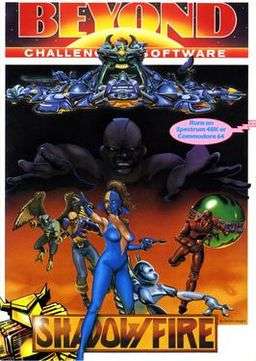Shadowfire (video game)
| Shadowfire | |
|---|---|
 | |
| Developer(s) | Denton Designs |
| Publisher(s) | Beyond Software |
| Platform(s) | ZX Spectrum, Commodore 64, Amstrad CPC |
| Release date(s) | 1985 |
| Genre(s) | Adventure / RPG |
| Mode(s) | Single-player |
Shadowfire is a computer game for the Sinclair ZX Spectrum and Commodore 64. It was developed by British developer Denton Designs and was published by Beyond Software in 1985. Shadowfire is notable as one of the first games to use a menu-and-icon-driven interface, even with a lightpen. It was followed by a sequel, Enigma Force, in 1986.
Plot
General Zoff, a traitor to the Empire is holding Ambassador Kryxix captive in his spaceship. Plans for a new type of spaceship (the Shadowfire of the games title) are contained in a micro-disc hidden in the Ambassador's spine. If Zoff gets the plans, the empire will be in great danger, and it is only a matter of time until his inquisitors will discover them. The Emperor has assembled the Enigma Force, a group of six operatives who are "...the cream of the Empire's legions, the worst of its criminal scum or the latest development in cybernetics." Your task is to rescue Kryxix, capture Zoff and destroy or capture his starship the Zoff V.
Gameplay

Players take control of all six characters and have one hour and forty minutes of realtime to rescue Ambassador Kryxix and capture General Zoff. All six characters have different abilities. Syylk is an insectoid and a strong fighter; Zark Montor, the team leader, is an expert in unarmed combat and the only translator of the group - meaning that Kryxix will only follow Montor; Sevrina Maris is the only character who can pick locks; Torik is an avian with thorough knowledge of explosives - and the fastest moving character; Maul is a slow combat droid; and Manto is a weak droid, but the only team member that can operate the transporter that is vital for the mission's success.
Controls are completely icon based and the screen is divided into six sections. The upper screen section is called the mission command screen and displays which character is active, the active character's location and the status of all characters: whether they are moving, engaged in combat, weak or dying or performing certain action such as picking locks. The lower half of the screen changes depending on the situation and shows additional information and all selectable actions.
From the main game screen (Enigma Force screen) players can choose one of the six characters and access four sub-screens:
- Character status screen: Shows a character's speed, strength, stamina (health) and carried weight.
- Object screen: Shows all objects present at a location as well as all objects carried by the selected character. It can be used to drop or pick up items, equip weapons and items, or use special items.
- Movement screen: Here, the active character can be moved by clicking on arrows that show possible directions for a character to move.
- Battle screen: During battles, characters can scan the location to count and identify their enemies, move, attack with or without a weapon, defend, or retreat.
Game/manual inconsistencies
Both the manual and the game are not always helpful towards the player:
- Not all of the character descriptions are useful: Torik's knowledge of explosives is of no benefit, as apart from a grenade (which can be used equally well by all characters,) there are no explosives to be found or used in the game, and Syylk's hatred of Zoff never leads him to disobey orders - despite the manual warning that this may happen.
- The manual states that there is an invisible monster (Zoff's pet) roaming the ship which will randomly attack the player. This was a bug in the Commodore 64 version which was subsequently fixed, but by then the manual had already been printed.[1]
- The mission objective after rescuing Kryxix is for the player to destroy the Zoff V via a self-destruct mechanism. However, if the player arms the device the game then jumps to game over with the message "Mission failed - Zoff V not captured"
- It is still possible to rescue Kryxix even if Montor is killed. However, this involves sending the relatively weak Manto into a hazardous section of the Zoff V, instead of allowing the offensive and far stronger Montor to retrieve Kryxix.
Reception
The game was well-received on both released platforms, gaining a 96% Crash Smash for the ZX Spectrum version,[2] and a 91% ZZap Sizzler award for the Commodore 64 version.[3] The innovative interface, multi-character gameplay and atmospheric music by Fred Gray were also favourably commented upon.
Shadowfire was unique at the time in that it was released with the ZX Spectrum version on one side of the cassette, and the Commodore 64 version on the other side. This ensured that Shadowfire rode high in the individual format charts, as both Spectrum & C64 sales counted as one, increasing the perceived popularity.
Sequel
The game was followed up by a sequel in 1986, named Enigma Force which featured a more arcade orientated style of gameplay. Whereas Shadowfire was entirely icon based, Enigma Force allowed the player to directly control the reduced list of characters, and play as an arcade game.[4]
References
- ↑ Denton Designs interview - Shadowfire bug "Sinclair User" (40). June 1985: 59.in , issue 40
- ↑ Crash review (Web Archive) "Crash Magazine" (17). June 1985: 16.
- ↑ ZZap64 review (Web Scan) "Zzap! 64" (1). May 1985: 66.
- ↑ Crash review of Enigma Force "Crash Magazine" (26). March 1986: 128.
External links
- Shadowfire at MobyGames
- Shadowfire at Lemon 64
- Images of Shadowfire box, manual and screen shots at C64Sets.com